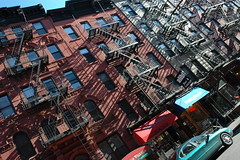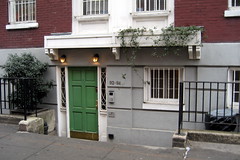West:
Corner: Ben's Pizzeria, opened 1966

121: Authentically charming
since 1927. Featured
in Godfather II, Serpico,
Next Stop Greenwich Village, and the original
Shaft. JFK gave a
speech out front in 1959.
119: Mamoun's Falafel, opened in 1971, is
said to be the first (of many) falafel
joint in town.

117:
Olive Tree Cafe, launched 1969,
Mediterranean joint where you can write on the
tables with chalk. Used to be the
Cock and Bull; before that it was
Swing Rendezvous, a 1940s lesbian bar.
The basement was The Underground in
1967, noted for its psychedelic light
screen. Now
The Comedy Cellar, which boasts talent
like Colin Quinn, Jerry Seinfeld and Jon Stewart.

115 (corner): A long-running
Greenwich Village club where Bob Dylan had his first NYC gig,
and Jimi Hendrix gained fame.
Peter, Paul & Mary, Kool and the Gang and
Bruce Springsteen are also claimed as
former performers, along with comedians
Richard Pryor and Bill Cosby.
|
W <=== MINETTA LANE
|
See a 360 degree panorama of this
corner.
Minetta Tavern
113: An Italian restaurant founded in
1937, it was a meeting place for
Ezra Pound, e.e. cummings, Ernest Hemingway, etc. Joe
Gould worked on his Oral History of the World
here; murals depict Village
history. Until 1929 was The Black Rabbit,
a speakeasy run by Eve Adams before Eve's Hangout;
Eugene O'Neill and
Max Bodenheim were customers. Reader's Digest was
founded in the basement in 1923.

The restaurant appears
in the movie Jimmy Blue Eyes as La Trattoria,
a mob-run joint--which is not so far-fetched,
given that the owner was busted for running an Ecstasy
ring in 2000. In 2008, it was acquired by restauranteur
Keith McNally, who planned to switch the menu from
Italian to French.
109: Off the Wagon Bar & Grill, formerly The Derby

107: Village Ma Thai was Rienzi's
coffeehouse, a James Dean hangout. "If a couple meets at
Rienzi's they break up at Figaro's and vice versa"--
New York Unexpurgated.
103: Panchitos, Mexican
99: Hummus Place; Kati Roll Company,
Indian street food. Before that the Samurai Bar,
aka The Smallest Bar in New York, was here.
97:
Monte's Trattoria, old-school
Italian founded 1918 as Razzazco. Run by
the brother of the chef at Villa Mosconi.
95: Tenement from
1888 has a sushi joint, Whatever Tattoo II
on the ground floor.
Site of the San Remo
93 (corner): Last I checked, it was the
Butterfly Grill, though it was easier to
find the painted-over old name,
Carpo's Cafe.
But it's most notable as the former site of the
San Remo, the famous
bohemian hangout of William Burroughs, Allen Ginsberg, Gregory Corso, Miles Davis, Jackson Pollock, W.H. Auden,
Dylan Thomas, James Baldwin,
William Styron,
James Agee,
Frank O'Hara, Village character Maxwell Bodenheim, photographer
Weegee, etc.

Gore Vidal once picked up Jack Kerouac here.
It lost popularity because
the bartenders beat up the customers once
too often.
The setting of the beat novel Go, it also
appears as The Masque in Kerouac's The Subterraneans.
Dawn Powell in The Golden Spur cited it
as one of the four bars that defined
the boundaries of the real New York.
|
|
|
East:

Corner (110 W. 3rd): NYU law school's
D'Agostino Hall (1986). "A fine work," says the AIA Guide.

130-132: Louisa May Alcott wrote Little Women
in this 1852 house.
128: Whatever Body Piercing Tattoo. What
would Louisa May think?
126: Silver World; Ali Baba Kabab House
124: Meskerem, tasty Ethiopian--
"You can even eat the dishes!"

122: Macdougal Ale House is in a
Romanesque tenement.
120: C'est Magnifique antiques and custom jewelry
118: Mexican Village

116: Below Frequency ("body piercing/ watches")
and Spring Gallery (Chinese gifts)
is the storied space of Alibi. It was previously
the Wreck Room and before that Scrap Bar,
a punkish bar with post-industrial decor.
In the 1970s, it had been El Cafe, a lesbian bar.
 In the 1950s it was the Gas Light Cafe, the "quintessential
Beat hangout"; it
launched the Village poetry-reading craze with readings
by Lawrence Ferlinghetti, Kerouac, Ginsberg, Corso, LeRoi Jones et
al.; Bob Dylan played here and stayed in a room
upstairs. Don Draper checked out the Beatniks here with his bohemian girlfriend in the first season of Mad Men. Before all that it was Louis' Luncheon,
hangout for writers,
Ziegfield Follies chorus girls, gays and lesbians.
In the 1950s it was the Gas Light Cafe, the "quintessential
Beat hangout"; it
launched the Village poetry-reading craze with readings
by Lawrence Ferlinghetti, Kerouac, Ginsberg, Corso, LeRoi Jones et
al.; Bob Dylan played here and stayed in a room
upstairs. Don Draper checked out the Beatniks here with his bohemian girlfriend in the first season of Mad Men. Before all that it was Louis' Luncheon,
hangout for writers,
Ziegfield Follies chorus girls, gays and lesbians.

114: Esperanto Caf� ("always open") was the
Kettle of Fish (now on Christopher Street), hangout of
Village characters
like Joe Gould and photographer Weegee. Bob Dylan
had a fight here with Andy Warhol over Edie Sedgwick;
Dylan also had his only meeting with
Jimi Hendrix here, when the two were
both too stoned to do anything more
than laugh.
112: Just Do It
110: Nails by Barneys; Cover Up boutique.
In 1957, this was Izzy Young's Folklore
Center, center of the folk explosion.
108: New Souvenir Cottage
106: Baraka Sterling Silver Jewelry; Excellent Photo
104: Yatagan Kabab House is recommended
by the Voice's Robert Sietsema as a cheap, friendly meat fix.
Silver Express shares the address.
102:
Slane, Irish bar/restaurant, was Brazil Grill
Ciao! Vineria con Cucina

100 (corner): Replaced Cafe Borgia when
its owners retired after 60 years. In a
beaux arts tenement that went up in 1904.
|
|

 Created 1833 as stables for the houses on Washington
Square North; Jackson Pollock stayed in
No. 9 in 1949-50. 10-10 1/2 was
playwrights salon in 1960s; 15 1/2-17 1/2 were
the first site of the Whitney Museum. In front
of No. 15 is one of New York's last gaslights.
Created 1833 as stables for the houses on Washington
Square North; Jackson Pollock stayed in
No. 9 in 1949-50. 10-10 1/2 was
playwrights salon in 1960s; 15 1/2-17 1/2 were
the first site of the Whitney Museum. In front
of No. 15 is one of New York's last gaslights.



























